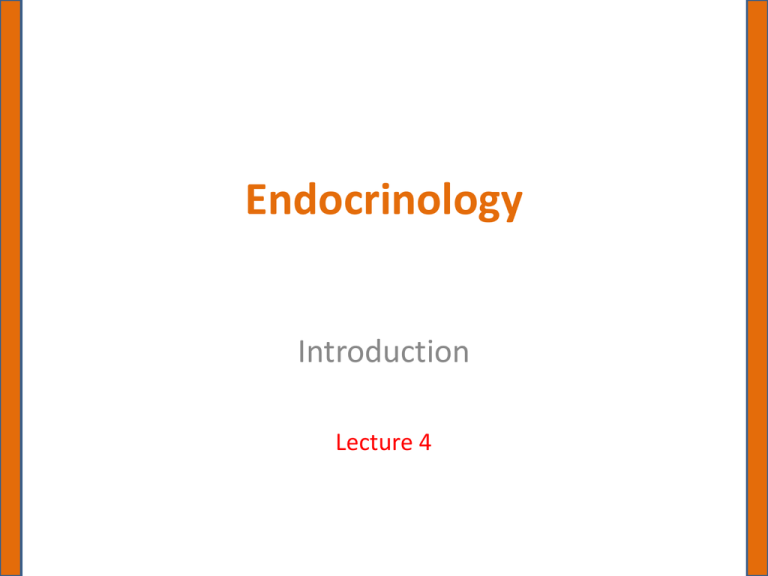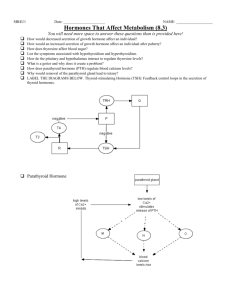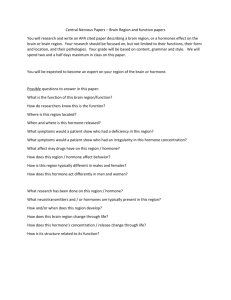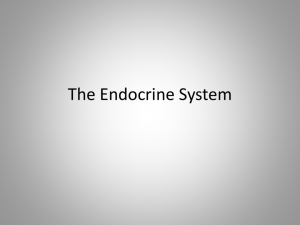Regulation of Hormone Secretion
advertisement

Endocrinology Introduction Lecture 4 Regulation of Hormone Secretion • For hormones to function as carriers of critical information, their secretion must be turned on and off at precisely the right times • The organism must have some way of knowing when there is: – a need for a hormone to be secreted, – how much is needed, – and when that need has passed Necessary Components of Endocrine Regulatory Systems • It is important to identify and understand the components of the regulation of each hormonal secretion because: – Derangements in any of the components are the bases of endocrine disease – and manipulation of any component provides an opportunity for therapeutic intervention Negative Feedback • Secretion of most hormones is regulated by negative feedback • This means that some consequence of hormone secretion acts directly or indirectly on the secretory cell in a negative way to inhibit further secretion • A simple example from everyday experience is the thermostat – When the temp. in a room falls below some preset level, the thermostat signals the heater to produce heat – When room temperature rises to the preset level, the signal from the thermostat to the heater is shut off , and heat production ceases until the temperature falls again • This is a simple closed-loop feedback system and is analogous to the regulation of glucagon secretion Negative Feedback of Hepatic Glucose Production by Glucagon • A fall in blood glucose detected by the alpha cells of the islets of Langerhans causes them to release glucagon, which stimulates the liver to release glucose and thereby increase blood glucose concentrations • With restoration of blood glucose to normal level or set point , further secretion of glucagon is inhibited • This mechanism is seen in some endocrine control systems • A problem that emerges with this system of control is that the thermostat maintains room temperature constant only if the natural tendency of the temperature is to fall • If the temperature were to rise, it could not be controlled by simply turning off the heater • Regulation is more efficient and precise, however, with a second, opposing loop, which is activated when the controlled variable deviates in the opposite direction Negative Feedback Regulation of Blood Glucose Concentration by Insulin and Glucagon • For the example with regulation of blood glucose, that second loop is provided by insulin • Insulin inhibits glucose production by the liver and is secreted in response to an elevated blood glucose level • Closed loop negative feedback control as just described can maintain conditions only in a state of constancy • Such systems are effective in guarding against upward or downward deviations from some predetermined set point • But changing environmental demands often require temporary deviation from constancy • This can be accomplished in some cases by adjusting the set point and in other cases by a signal that overrides the set point • For example, epinephrine secreted by the adrenal medulla in response to some emergency inhibits insulin secretion and increases glucagon secretion even though the concentration of glucose in the blood may already be high • Whether the set point is changed or overridden, deviation from constancy is achieved by the intervention of some additional signal from outside the negative feedback system Positive Feedback • Some consequence of hormonal secretion acts on the secretory cells to provide an augmented drive for secretion • A good example of a positive feedback system involves oxytocin causing contraction of uterine muscle during childbirth • In this case the stimulus for oxytocin secretion is dilation of the uterine cervix • Upon receipt of this information through sensory nerves, the brain signals the release of oxytocin from nerve endings in the posterior pituitary gland • Enhanced uterine contraction in response to oxytocin results in greater dilation of the cervix, which strengthens the signal for oxytocin release and so on until the infant is expelled from the uterine cavity Positive Feedback Regulation of Oxytocin Secretion 1. 2. Uterine contractions at the onset of parturition apply mild stretch to the cervix In response to sensory input from the cervix (blue arrows), oxytocin is secreted from the posterior pituitary gland, and stimulates (green arrows) further contraction of the uterus, which, in turn stimulates secretion of more oxytocin 3. 4. This lead to further stretching of the cervix, and even more oxytocin secretion & 5. until the fetus is expelled Measurement of Hormones • It is often necessary to measure how much hormone is present in some biological fluid for: – for the purpose of diagnosing a patient’s disease – or research to gain understanding of normal physiology • Chemical detection of hormones in blood is difficult • Their minute concentrations further complicates the problem of their detection Immunoassays • As knowledge of hormone structure increased, it became evident that peptide hormones are not identical in all species • Hormones isolated from one species were recognized as foreign substances in recipient animals of another species, which often produced antibodies to the foreign hormone • Antibodies are exquisitely sensitive and can recognize and react with tiny amounts of the antigens that evoked their production, even in the presence of large amounts of other substances that may be similar or different Radioimmunoassay • A typical radioimmunoassay takes advantage of the fact that iodine of high specific radioactivity can be incorporated readily into tyrosine residues of peptides and proteins • This permits detection and quantitation of tiny amounts of hormone • Hormones present in biological fluids are not radioactive, but can compete with radioactive hormone for a limited number of antibody binding sites Radioimmunoassay • Labeled hormone ( H, in red) competes with the hormone in a biological sample (green H) for a limited amount of antibodies ( Ab) • As the concentration of hormone in the biological sample rises (rows 1,2, and 3) decreasing amounts of the labeled hormone appear in the hormone-antibody (H-Ab) complex and the ratio of bound/free labeled hormone (B/F) decreases • A typical standard curve used to estimate the amount of hormone in the biological sample • A B/F ratio of 50% corresponds to 12 ng/ml in this example Radioimmunoassay • Although this procedure originally was devised for protein hormones, radioimmunoassays are now available for all the known hormones • Production of specific antibodies to non-protein hormones can be induced by first attaching these compounds to some protein, like serum albumin • For hormones that lack a site capable of incorporating iodine such as the steroids, another radioactive label can be used or a chemical tail containing tyrosine can be added • Methods are even available to replace the radioactive iodine with fluorescent tags or other labels that can be detected with great sensitivity Immunometric Assays • Two different antibodies that recognize different immunological determinants in the hormone are used • One antibody is coupled to a solid support such as an agarose bead or adsorbed onto the plastic of a multiwell plate • The biological sample containing an unknown amount of hormone then is added under conditions in which there is a large excess of antibody so that essentially all the hormone can be bound by the antibody • The second antibody, linked to a fluorescent probe or an enzyme that can generate a colored product, then is added and allowed to bind to the hormone that is held in place by the first antibody so that the hormone is sandwiched between the two antibodies and acts to link them together Hormone Levels in Blood • It is evident now that hormone concentrations in plasma fluctuate from minute to minute and may vary widely in the normal individual over the course of a day • Hormone secretion may be episodic, pulsatile, or follow a daily rhythm • Endocrine disease occurs when the concentration of hormone in blood is inappropriate for the physiological situation rather than because the absolute amounts of hormone in blood are high or low Disorders of the Endocrine System • Classic disorders of the endocrine system arise from states of excess or deficiency of hormones, but resistance to hormones also plays a major role in disease









